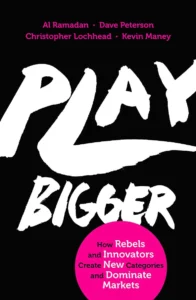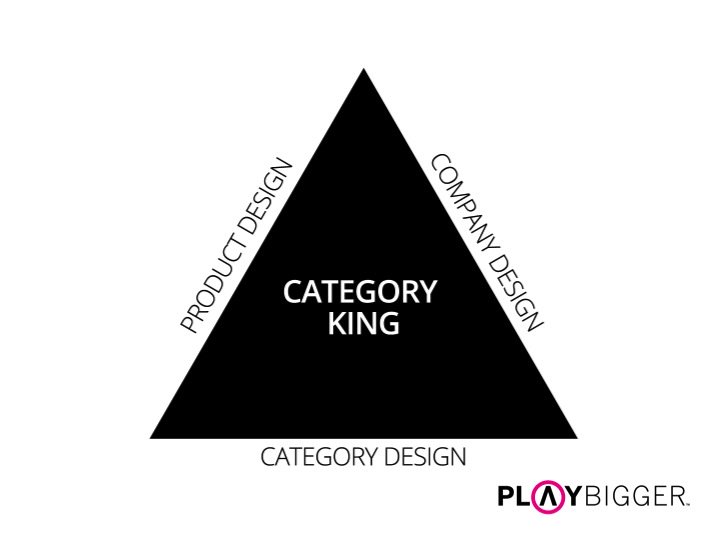I have read many business books over the years. Consequently, I always find inspiration and valuable nuggets that I can apply, so reading for me is an essential way to develop and grow by learning from others.
Collective wisdom always outshines individual judgement
Some of my favourite business books are shown below. As far as I am concerned they are a must-read for anyone who works in the marketing function, in fact any business function.
- Decision Science by Phil Barden
- How Brands Grow by Byron Sharp
- Good to Great by Jim Collins
- The Lean Startup by Eric Ries
- Crossing the Chasm by Geoffrey Moore
- Business Model Generation by Alexander Osterwalder and Yves Pigneur
However, I recently came across a book that really is a game changer for marketers. The book is Play Bigger. It was written in 2016 so I am not sure why I never came across it before. But Play Bigger absolutely nails how to set a company up for the highest probability of business success. Their approach is ground-breaking. Buy it here.

The aspects of Play Bigger that I love
- It provides a very inspirational and pragmatic approach for a company to establish its vision and true north.
- It encapsulates and brings together a range of different and highly valuable business best-practice strategies into a single integrated approach.
- It focuses, first and foremost, on the problem to be solved and is so doing ensures that all decisions are made from a customer / market understanding.
- The recommendations are organised into a sequential structure that is easy to understand, adopt and apply to your business.
The Play Bigger premise
The crux of Play Bigger is based on the premise that to win in business you need to differentiate yourself by creating a new category. This can be a new category of business or a new way of doing business. From there you then need to dominate that category to become the category king. However, to achieve this you need to place roughly equal effort into building the category, the product and the company.
Most companies forget to invest in category building which conditions the market to the problem and ultimately positions your company as the best company to solve it.

Winning today isn’t about beating the competition by being better. It’s about creating a new market category, developing it and dominating it over time
Play Bigger
Here is my Gist of what Play Bigger has to offer and it runs you through the steps of how to Define, Develop and Dominate your category.
STEP 1: Confirm the category
- Define who will lead the project.
- Undertake a workshop to uncover – who your customers are, the problem to be solved, the ‘froto’ (where you are taking your customers From:To – same as the AS IS : TO BE concept) and defining what’s the new thing / what’s different?
- Name the Category – conveying clarity whilst highlighting differentiation.
- Fact finding – undertake interviews and data analysis to deliver insights to inform views (see below).
- Develop and deliver the Category Design Document (see below).
Fact finding (areas to be covered in interviews)
- Vision / mission – original market/technology insight that the company focused on?
- Customers – who will buy/use your solution?
- Problem statement – what are you solving for your customers?
- Use cases – what are the specific ways your solution will be used?
- Product/solution – what does your product do / could it do?
- Ecosystem – other companies or control points involved in solving the problem?
- Competition – who else is competing to solve the problem?
- Business model (value delivery) – how will it change business and create value: efficiency, effectiveness, speed and / or new?
- Sales and GTM – define channel, marketing, sales process and pre-sales / onboarding?
- Organization – confirm structure, key influencers, decision-making process and key principles (culture).
- Funding strategy – confirm how much runway there is, what financial constraints you are operating under and anything else that impacts investment requirements.
STEP 2: Deliver Category Design Document
- Category Landscape – what does the landscape look like?
- Category Ecosystem – who participates; customers, partners, competitors, developers, suppliers, analysts, media?
- Frotos – what is the before & after state from a customer perspective from the adoption of your solution?
- Category Name & description.
- Business case for the category – why should it exist? What is the impact of the problem and what are the benefits of resolving it?
- Draft game plan – define how you will proceed to create & dominate the category over time.
STEP 3: Create & embed a Point of View (POV) in the company
- Confirm who leads the development of the POV Document (your story).
- Undertake further fact finding to confirm how the strategy will be implemented and to guide the development of the right company culture:
- How both the company & its products are different (not better).
- Provide a clear & achievable roadmap to solution development.
- Define the envisioned outcome for the company – set OKRs (Objectives & Key Results) both tangible and intangible as appropriate.
- Nature of the company – describe how the market will see the company in the future in terms of types of people, overall culture, its image / reputation and its positioning / vision (why it exists).
- Agree on problem – frame the problem with clarity to get to people’s emotions.
- Craft the story – make sure this is simple (easy to comprehend), human, provocative, emotional, & visual whilst also being sprinkled with your own unique personality.
- Then Distribute, Evangelise and Mobilise (plan).
Why create a POV?
- Confirms the problem you are solving.
- Identifies the ramifications for solving the problem.
- Establishes your Vision – true north to guide all future business decisions.
- Conveys how you will build the category.
- Confirms potential outcomes of succeeding in the category.
- Note: POV – long (10/20 slides) versus Elevator Pitch – short
Benefits of a POV
- Conditions the company (this is the first step).
- Conditions the market (after gaining clarity & alignment internally, the next opportunity is to condition the market to the problem and how you will go about solving it).
- Ensures you hire the right people.
- Enables improved investor relations.
- Achieves employee alignment:
- Deploy training for everyone – cascade down through organisation using small groups
- Use reminders at every opportunity e.g. laminated cards
- Build confidence & commitment by asking all senior managers and directors to present the POV to their peers. Builds consistency, alignment & sharing of best-practice.
- Guides future product development and roadmap.
- Steers Brand development to align the category, product and company story together.
STEP 4: Mobilise your POV and launch to the market
- Avoid gravity – use your POV to stay on point and not to be distracted by customer requests, promises made by your sales team, tactical competitor actions etc.
- Develop a LIGHTENING STRIKE (a shock & awe event that creates significant coverage & interest in the market)
- Hijack an event
- Own your own big event
- Launch the Lightening Strike within 3 – 6 months of the POV rollout
- Prepare for the Lightening Strike by focusing the whole company on pulling it off successfully:
- Enable customer-facing teams e.g. sales deck
- Optimise press – air wars
- Update the brand – make it distinguished – difficult to miss
- Update your use cases and create a Value Framework (including metrics and methodologies) to convey the value delivered
- Engage and activate key influencers e.g. Industry Analysts
- Knuckle down on Growth Hacking – ground wars – to generate demand
- Update website – narrative, SEO, adwords – it is your ANCHOR and use it as your source of truth
Lightening Strike mobilisation documents
- Category blueprint: it defines the vision & architecture for the category – it conveys leadership and lifts the company above other competitors. Provides the basis for external evangelisation.
- Product taxonomy – it confirms your offer. It might involve repackaging and repricing your product and creating a taxonomy – naming convention – that reinforces the problem you are solving.
- Use cases – these need to be specific & detailed – each Use Case must confirm the problem, how it was solved and the corresponding value that was delivered (Problem – Solution – Benefit). To be achieved in a way that highlights what is different & valuable.
- Category ecosystem – confirms all the outside players as well as identifying the control points that you need to harness and take the lead on.
Lighting Strike (LS) process
- Lead: confirm the leaders for this process – CEO and LS master controller.
- Timing; set date & create plan for executing on the LS.
- Mobilise everyone: assign responsibility and tasks across the organisation. make sure everyone knows their role, the importance of their contribution and the interdependencies where other team members rely on them.
- Deliver LS documents.
- Verify that it will work. Sometimes companies can get ahead of their actual capabilities. Make sure you don’t do this by verifying your vision and POV with the capabilities you can actually deliver.
- Watch for trouble and evangelise to keep everyone onboard. Very important. Address any doubters as soon as an issue arises.
- Get it done! Make it happen. Until you try you never really know what is possible.
STEP 5: Condition the market
- Run teasers (thunderclaps) in advance of the LS to garner excitement to the upcoming event.
- Use an Industry event, your own event, a product launch or a media event (letter) as the basis for the LS.
- Run a series of coordinated events ( each one building on the other) to keep up momentum and to reinforce and grow market perception.
- Run events in all offices (involve and include all stakeholders). Everyone must be involved. Even small activities will, when combined with others, make a significant incremental contribution.
- Sync with entire ecosystem inc. partners by leveraging their network, reach and communications capabilities.
- Target precisely – engage with those potential customers that, once the problem is understood, will see clear value in it being solved through a different & more valuable solution. Know your ideal customers.
- Content:
- Be big, bold and distinguished.
- Evangelise the category problem – be seen as the thought leader, innovator and rebel.
- Remember the Event is also the message so it must be in tune.
- Hijack competition news, at any opportunity to tell your ‘different’ story.
STEP 6: Continue playing bigger
- Don’t stop after the LS. You need to keep the flywheel moving of its own volition.
- Confirm who leads this:
- Master controller
- Small team
- Chief hijacker (head of communications)
- Planning – have weekly meetings, build teamwork, keep on station, use RAGs to identify and address issues & risks.
- Make sure your event planning has a dedicated resource (everything must be done to ensure every event works).
- Ensure a consistent narrative to build market presence & understanding.
- Plan post event activities – this is essential to maintain momentum.
- Review, prioritise, and go again ……. and again
There is clearly a lot more in Play Bigger and it explains all the key principles, with examples, in far reacher detail but hopefully I provided you with a brief summary on what you will learn.
If everything seems under control, you’re just not going fast enough.
Mario Andretti
Read Play Bigger now
So, ignore this opportunity at your peril. Read Play Bigger now!
After all, if you have ever struggled to gain the recognition you deserve for both your team and as CMO, now is the time to change the narrative. It really is your chance to excel. Grab Play Bigger with both hands and use it to transform your company’s business landscape for the better.
